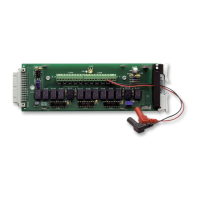Service Information
4-3
V
REF
= (T
J
+ 273.15)
×
0.0002
7. Read the voltage across the output of OUT A (Model
2001 #2). Compare the measured and calculated voltag-
es. If they differ by more than 72
µ
V (0.36
°
C), perform
the calibration procedure of paragraph 4.4.1.
Table 4-1
Verification and calibration equipment
Description Model or part Specifications Applications
DMM* Keithley Model 2001 20Ω, 72ppm
200kΩ, 90ppm
200mV, 37ppm
Path resistance
Calibration
Reference junction, calibration
Electrometer w/voltage source Keithley Model 6517 20pA, 200pA; 1.6%
200V source; 0.05%
Offset current, path isolation
Sensitive Digital Voltmeter Keithley Model 182 3mV; 60ppm Contact potential
Triax cable (unterminated) Keithley Model 237-
ALG-2 — Offset current
Low thermal cable (untermi-
nated)
Keithley Model 1484 — Contact potential
Thermistor probe Thermometrics Series
CSP A207A
±0.005°C accuracy Reference junction, calibration
Reference thermometer — ±0.01°C w/thermistor Reference junction, calibration
Distilled water ice bath
(Dewar flask or Thermos)
— ±0.1°C Calibration
#22 AWG solid copper wire — — Path resistance
#22 AWG Teflon-insulated
stranded wire
— — Path isolation
* Two DMMs are required for thermistor calibration method and reference junction test.
4. Coat the probe with a thermally conductive compound,
and insert it into the 0.110” hole marked “CAL” on the
Model 2001-TCSCAN printed circuit board.
5. Use the Model 2001 #1 front panel CHAN key to close
Channel 1.
6. Take a reading from the reference thermometer (T
J
). Use
the following equation to calculate the equivalent refer-
ence junction output voltage (V
REF
):

